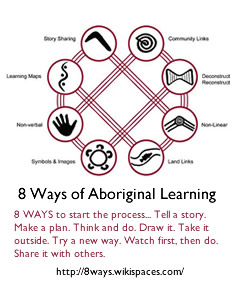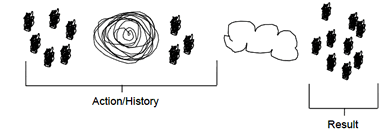Home > Indigenous Learners > Starting Points > Maths as Storytelling
Maths as Storytelling
The Maths as storytelling (MAST) approach utilises Indigenous knowledge of symbols (within, e.g., sport, driving, art and dance) as a starting point for building understanding of arithmetic symbolism in a way that can be easily extended to the symbolism of algebra.
The approach has five steps.
Step 1
Students explore the meaning of symbols and how symbols can be assembled to tell and create a story. This is initially done by looking at symbols in Indigenous situations (e.g., exploring and understanding symbols in paintings) and then creating and interpreting symbols for simple actions (e.g. walking to and sitting in a desk).
Step 2
Students explore simple addition story by acting it out as a story (e.g. two groups of people joining each other). A discussion is then generated to identify the story elements such as the different groups of people and the action (the joining of the two groups) and the consequences of the action (the result of the joining).
Step 3
Students create their own symbols to represent the story. This step could be done in a freestyle manner; however, we have opted to take a more structured approach by using concrete materials (which are familiar to the students) to represent the objects (or people) in the story. The story is then created by allowing the students to construct the two groups of people with the concrete materials and construct their own symbol for “joining two groups” and lay this out to represent the action (or history) of the story. In a similar fashion, the students then construct their own symbol for “resulting in” or “same as” to tell the story of what happens after this action has taken place. Figure 1 gives an example of an addition story that was constructed by a student in Year 2.
Figure 1. A Year 2 student’s representation of the addition story 6+3=9
Step 4
Students share their symbol systems with the group and any addition meanings their symbols may have. For example, in Figure 2, the student’s “joining” Figure 2. A Year 2 student’s representation of the addition story 6+3=9
Step 4. Students share their symbol systems with the group and any addition meanings their symbols may have.
For example, Figure 2, the student’s “joining” (PME paper for 2007 on Indigenous symbols), where the symbol is a vortex that sucked the two groups together MAST Addition stories, 9/1/2008, Page 4). The teacher then selects one of the symbol systems for all the students to use to represent a new addition story. This step is important to accustom students to writing within different symbol systems and to develop a standard a classroom symbol system.
Step 5
Students modify the story (a key step in introducing algebraic ideas) under direction of the teacher. For example, the teacher takes an object from the action part of the story (see Figure 2). The teacher asks whether the story still makes sense, which normally is a resounding no, and then challenges the students by asking them to find different strategies for the story to make sense again.
There are four possibilities:
- putting the object back in its original group,
- putting the object in the other group on the action side,
- adding another action (plus 1) to the action side, and
- taking an object away from the result side.
The first three strategies introduce the notion of compensation and equivalence of expression, while the fourth strategy introduces the balance rule (equivalence of equations). At this step, students should be encouraged to play with the story, guided by the teacher, to reinforce these algebraic notions.
[contributed to by Dr Chris Matthews]
Culture and mathematics Aboriginal and Torres Strait Islander perspectives
This resource supports teachers to embed Aboriginal and Torres Strait Islander perspectives in the mathematics curriculum. While this resource looks at an approach to mathematics through an Aboriginal and Torres Strait Islander perspective, it will benefit the teacher and students in any classroom. QSA would like to thank Dr Chris Matthews, an Aboriginal man from the Quandamooka Nation (Moreton Bay, Queensland), for his personal consultation and his writings.
Aboriginal and Torres Strait Islander Education : An introduction for the teaching profession
Aboriginal and Torres Strait Islander Education : An introduction for the teaching profession is a text authored edited by Dr Kaye Price. This text responds to the Australian Government's commitment to 'Close the Gap' on Aboriginal and Torres Strait Islander disadvantage. The book prepares students for the classroom and community environments they will encounter when teaching Aboriginal and Torres Strait Islander children in urban, rural and remote schools at early childhood, primary and secondary levels. It assists teacher education students to understand the deeper social, cultural and historical context of Aboriginal and Torres Strait Islander Education.
Dr Chris Matthews, Connect with Maths Community Leader, has written chapter seven, 'Maths as storytelling: Maths is beautiful'.
Text or Kindle version available online from Amazon or text only from the Nile.com
- Publisher: Cambridge University Press, September 28, 2012
- ISBN-10: 1107685893
- ISBN-13: 978-1107685895
Maths as Storytelling
Melvyn Bragg and guests discuss the relationship between maths and storytelling. Is there a hidden mathematical logic in stories? The American mathematician John Allen Paulos thinks so.


